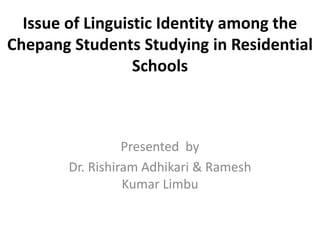
Issue of Linguistic Identity among the Chepang Students
- 1. Issue of Linguistic Identity among the Chepang Students Studying in Residential Schools Presented by Dr. Rishiram Adhikari & Ramesh Kumar Limbu
- 2. Introduction of the Chepang The Chepang is one of the indigenous nationalities , living in central hilly regionChitwan Makawnapur, Dhading and Gorkha ( see annexes ,Chepang area in the map of nepal Total population 68,399 (CBS Report, 2011).Nepal Chepng Association estimates 75,000, mother tongue speakers, more than 40,000.
- 3. Introduction of schools Antodaya was established with the initiation of late Kishor Chandra Dhungana and is still running under his trust. Accommodate 150 Chepang students ) Nabodaya school is running under the catholic community. Accommodate around 250 students
- 4. Objectives Focus on the issue of linguistic identity of the Chepang students studying in residential schools of Chitwan district Analyzes the schools situation and claim of schools Highlight the teaching learning activities and linguistic and cultural identity of Chepang
- 5. Research Questions why the schools have given less priority to preserve linguistic and cultural identity of Chepangs how linguistic and cultural identity of the Chepang is replaced by teaching learning languages what factors are responsible for the linguistic and cultural shift of the Chepang students
- 6. Research methodology Qualitative techniques Interview as tools visit schools(Antodaya and Nabodaya) ,collect infofation Reach into conclusion
- 7. Language and Identity Languages are the ways of expressing and recognising identities of people. Language is acquired naturally and taught formally. Natural acquisition and formal teaching create links between languages and identities. Linguistic phenomena are important that link between communal identity and national identity
- 8. Context Schools provide information in so called official language and children learn to read and write the language. In the context of Nepal, Nepali/English language is used for teaching learning language in formal schools and other languages are used only for talking inside community. After separating children from their community and home environment they encounter new environment that compel them to speak either English or Nepali
- 9. Through class room activities and hostel environment they acquire Nepali and English language that replace their mother tongue as they are living far from their home and community environment. With the change of language, an acquisition of their identity is being shifted from past to present.
- 10. Theorist Shi (2006:4). Chris Barker (2003…… Norton (2000) Hall (1996) Belz, 2002 etc.
- 11. Situation identity of Chepang language speakers is co-constructed and contextualized as they maintain and build connections with both or multiple languages and cultures. Residential schools do force them to negotiate either with Nepali culture or with Christian culture. In Antodaya School. Nabodaya School, the system is different and children should pray to god in the morning since school environment is controlled by catholic community. They address female teacher as sister and male teacher as father. Children negotiate with catholic belief and practice catholic values which are different from their village environment. Even if they occasionally speak Chepang language that seems to be odd and that can't capture the cultural background of Chepangs. Language and identity are interplayed through environment that constructs cultural identity. So, issue of linguistic identity becomes crucial in residential schools.
- 12. Linguistic identity of Chepang is being the matter of discussion rather than the practice and thus becomes more ambiguous than the past. In Nabodaya follow catholic faith and pray gods on their language which is odd and strange. In Antodaya, there is Nepali speaking and almost Hindu envornment.
- 13. Findings children studying in residential schools are easily distracted from their traditional identity and adopt new identity The schools are near to the town and they only go to their community during the time of vacation so they are disconnect with community. Schools administration has become unable to create such cultural and linguistic text for Chepang children
- 14. Catholic community emphasizes the issue of Chepang language and the language is used to promote Christian belief rather than the traditional and indigenous knowledge of Chepang Local political party leaders and Chepang activists support the mission of the catholic community through residential schools
- 15. Conclusion Chepang identity is no longer exactly the same as what residential schools have claimed. Chepang identity is seen being formed through negotiation between the prescribed text-books and their perception of learning from their culture. The classroom language learning situation is quite different and it gives false impression toward mother tongue.